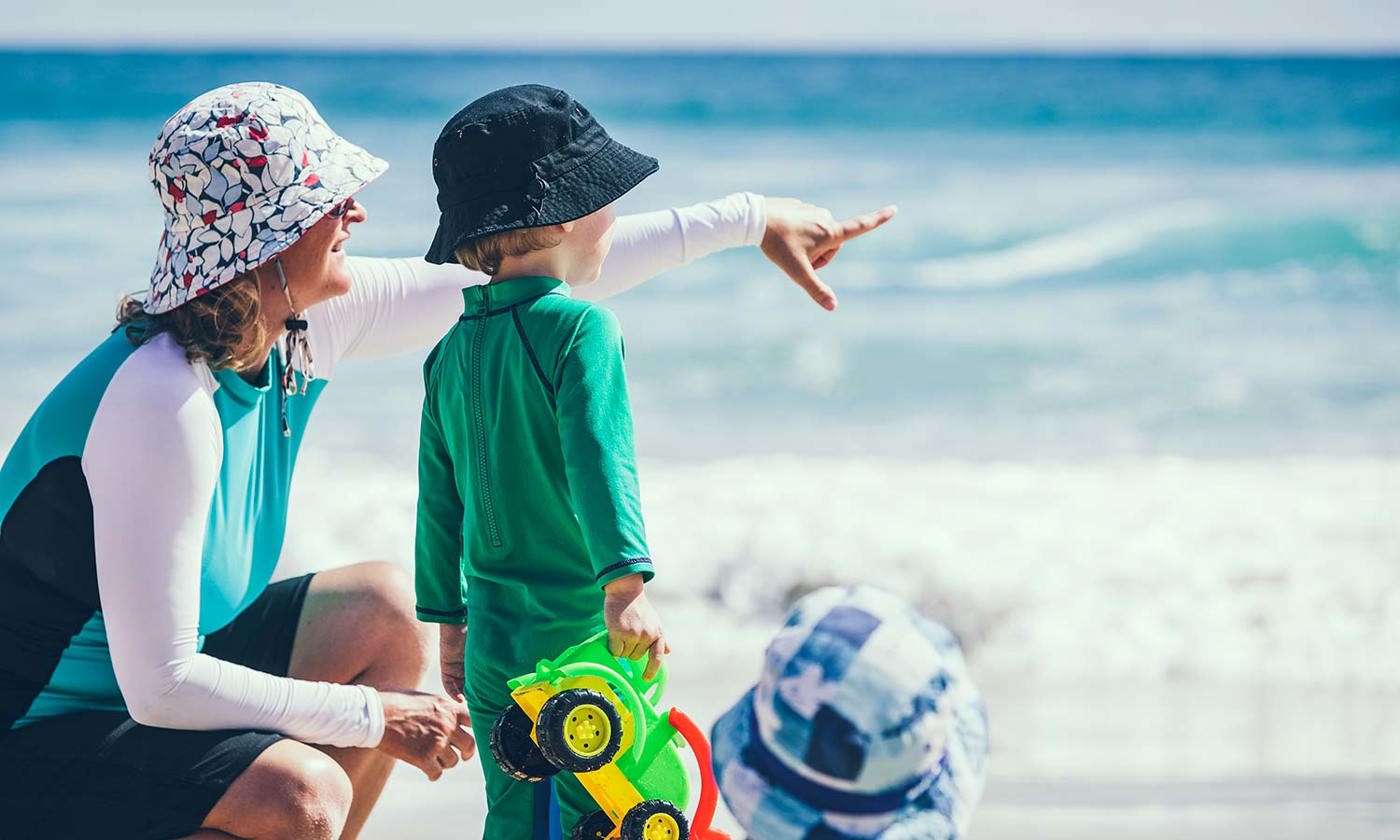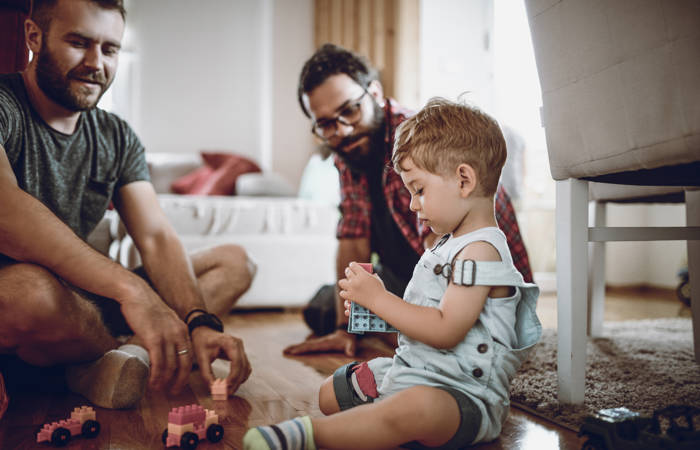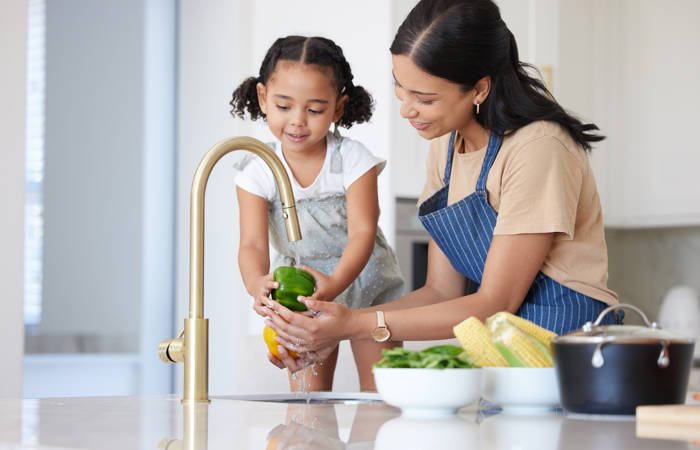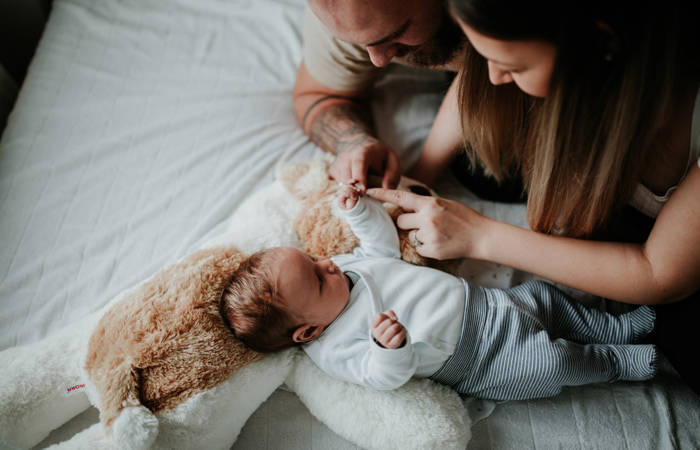Like what you see?
Sign up to receive more free parenting advice.
Thank you for subscribing to our newsletter!
Child Development

Credit: iStock.com/davidf
Let’s take a quick quiz.
1. Finish this phrase
SLIP, SLOP, _____, SEEK, ________
2. I only need to use sun protection when it’s hot and sunny.
a) True
b) False
3. Which of these answers is NOT correct?
The sun’s ultraviolet (UV) radiation can cause…
a) Skin damage
b) Eye damage
c) Sunburn
d) Windburn
e) Skin cancer
(You can check your answers at the end of the article.)
How did you go? Many of today’s young parents grew up with SunSmart messages as they slapped on their hat before recess, slopped on sunscreen during family holidays and slipped on rashies before swimming lessons.
Justine Osborne is SunSmart Schools and Early Childhood Program Coordinator for Cancer Council Victoria, and Chair of the National Schools and Early Childhood Working Group, National Skin Cancer Committee, Cancer Council Australia. Justine says the SunSmart message is being passed down through generations.
“As your parents and carers were learning about the dangers of overexposure to the sun’s UV, they were making sure these dangers didn’t reach you,” she says.
“Now as parents and carers of young children yourselves, it’s your turn to help create the new SunSmart Generation. Sun protection is an essential life skill for any child growing up in Australia.”
Why be SunSmart?
Justine says Australia has one of the highest rates of skin cancer in the world.
Two in three Australians will develop some form of skin cancer over their lifetime.1 About 2,000 Australians die from skin cancer each year.2
Infants and toddlers up to four years of age are particularly vulnerable to UV damage due to lower levels of melanin and a thinner stratum corneum (the outermost layer of skin).3
UV damage accumulated during childhood and adolescence is strongly associated with an increased risk of skin cancer later in life.4 5 6 7
“The good news is skin cancer is one of the most preventable cancers. The steps you take today can have a big impact on future skin cancer risk,” Justine says.
What causes skin cancer?
“The sun gives us sunlight that we see, infrared radiation (heat) that we feel and ultraviolet (UV) radiation that can’t be seen or felt. UV levels can be high on warm, sunny days and on cool, cloudy days. Too much of the sun’s UV can cause sunburn, skin and eye damage and skin cancer.
“Australia experiences some of the highest levels of UV radiation in the world because our country is close to the equator and has a relatively high number of days with clear skies.
“The Earth's orbit also means countries in the southern hemisphere, including Australia, are closer to the sun during our summer season compared to countries in the northern hemisphere.
“UV can reach us directly from the sun. It can also be reflected off surfaces and scattered by particles in the air. The free seeUV app (http://www.sunsmart.com.au/tools/interactive-tools/free-sunsmart-app-campaign) uses augmented reality to depict what UV might look like in your outdoor location if you could see it. It’s a great reminder of the presence of this unseen hazard.”
When do we need sun protection?
Sun protection is recommended whenever UV levels reach three or higher.
The free SunSmart app provides daily UV levels and sun protection times for locations across Australia. These are based on the Bureau of Meteorology forecast for UV levels, with live UV levels from ARPANSA. Sun protection times and UV levels are also available from MyUV.
In the northern parts of Australia sun protection is a year-round ritual. Southern locations can usually take a break during the winter months when UV levels are low.
Sun protection is recommended at all times for people who work outdoors, spend extended time outdoors or when near highly reflective surfaces such as water or snow or at high altitudes.
Five SunSmart steps
Justine says children watch and copy what adults do.
Preventive habits learned during a child's formative years are less resistant to change than those acquired in adulthood.8 9
When parents use sun protection such as hats, shade, sunscreen, and clothing, their children are more likely to use these sun protection methods too.10
Research shows that teenagers who used sunscreen generally had parents who insisted on sunscreen use when those teenagers were children.11
Justine says that during the sun protection times, when the UV is 3 or higher, families should remember these five SunSmart steps:
1. SLIP on clothing that covers as much skin as possible.
If you can see skin, UV can reach it. Cool, loose fitting clothing made from densely woven fabric can be an effective barrier between the sun’s UV and skin.12 Help children make good sun-protective clothing choices for outdoor play by having tops with higher necklines and longer sleeves and longer style shorts or skirts available for them to choose from. Try layering – a favourite singlet top with a shirt over it, or a favourite singlet dress with a t-shirt underneath. Choose rashies for swimming. Look for clothing labelled UPF50 which helps provide the best possible protection.
2. SLOP on SPF30 (or higher) broad-spectrum, water-resistant sunscreen.
Apply sunscreen to any parts of skin not covered with clothing about 20 minutes before going outside and reapply every two hours or more often if it has been wiped or washed off. Consider a sensitive or toddler formula sunscreen for young children. These are just as protective, but much gentler on their skin. Remember sunscreen is not a suit of armour and should only ever be used with other sun protection measures. Store sunscreen below 30 degrees and monitor the expiry date.
The widespread use of sunscreen on babies under six months is not generally recommended as babies have very sensitive skin which may be more likely to suffer a reaction.13
If you are concerned about reactions to sunscreen, Cancer Council recommends performing a usage test before applying a new sunscreen, where a small amount of the product is applied on the inside of the forearm for a few days to check if the skin reacts, prior to applying it to the rest of the body.
To help develop independent skills for school, it is recommended children from about three years learn how to apply their own sunscreen under supervision. Set up a sunscreen station at home with a pump pack and mirror. It may be near the door or on the bathroom bench. Make sunscreen application a bit of fun and encourage children to put a dot of sunscreen on each cheek, nose and their chin and carefully rub it in (avoiding the eye area). They can add squiggles of sunscreen to any part of their arms and legs not covered with clothing. Apply your sunscreen at the same time so children can watch how you do it and follow your example.
3. SLAP on a hat that shades the face, neck and ears,such as a wide-brimmed, bucket or legionnaire hat. Caps do not provide enough protection and are not recommended.
For young babies, choose a fabric that will crumple easily when they put their head down. Consider the hat’s size and comfort, the amount of shade it provides to the face, if it will obstruct vision, hearing or safety. Hats that can be adjusted at the crown are best. If the hat is secured with a long strap and toggle, ensure it has a safety snap, place the strap at the back of the head or trim the length so it doesn’t become a choking hazard.14 15
Help make hat-wearing a regular part of the outdoor routine. Make sure children have a favourite sun hat they like to wear and can easily find and access it. Perhaps have a special basket or hook to store hats so children know where to grab them from. Don’t forget to grab your hat too.
4. SEEK shade.
It is recommended that babies under 12 months are kept away from direct sun when UV levels reach 3 or above. Keep them in dense shade or when moving about, choose a pram cover that combines a mesh section for visibility and air circulation with a shade fabric section. The fabric section should block close to 100% of UV radiation (UPF50+) and the mesh section should block at least 70% of UV radiation (UPF3.3).
Encourage children to find shady spots for their outdoor play. They can move their activities to follow the shade. Perhaps they can help you create shady play spaces by laying a blanket under the tree, choosing a good spot for the shade umbrella or helping to drape thick fabric such as canvas over the clothes line for a built-in shade tent. You may need to take shade with you for family outings or choose places well known for their great shade.
5. SLIDE on sunglasses. Make sure they are wrap-around style labelled AS1067.
Toy or fashion-labelled sunglasses do not meet the requirements for sunglasses under the Australian Standard and should not be used for sun protection.
Some babies’ sunglasses have soft elastic to keep them in place.
Wearing a hat with a brim that shades the eyes can reduce UV radiation to the eyes by 50%.16
For more information visit cancer.org.au or call 13 11 20.
Need information in another language? Call 13 14 50 and ask to be connected to Cancer Council in your language;
For UV levels and sun protection times download the free SunSmart app, visit MyUV or the Bureau of Meteorology.
Quiz Answers:
1. SLAP, SLIDE 2. b) False 3. d) windburn
1 Staples MP, Elwood M, Burton RC, Williams JL, Marks R, Giles GG. Non-melanoma skin cancer in Australia: the 2002 national survey and trends since 1985. Medical Journal of Australia 2006; 184(1): 6-10.
2 Australian Bureau of Statistics. Causes of Death, Australia 2013. 3303.0. Commonwealth of Australia: Canberra, Australia 2015. Available from: http://www.abs.gov.au/AUSSTATS/abs@.nsf/DetailsPage/3303.02013?OpenDocument
3 Paller AS, Hawk JL, Honig P, Giam YC, Hoath S, Mack MC, Stamatas GN. New insights about infant and toddler skin: implications for sun protection. Pediatrics 2011; 128(1): 92-102
4 Armstrong BK. How sun exposure causes skin cancer: An epidemiological perspective. In: Hill D., Elwood J. M. and English D. R. (Eds). Prevention of Skin Cancer. Dordrecht, The Netherlands: Kluwer Academic Publishers, 2004, pp. 89-116.
5 Whiteman DC, Whiteman CA, Green AC. Childhood sun exposure as a risk factor for melanoma: A systematic review of epidemiologic studies. Cancer Causes & Control 2001; 12(1): 69-82
6 Khlat M, Vail A, Parkin M, Green A. Mortality from melanoma in migrants to Australia: Variation by age at arrival and duration of stay. American Journal of Epidemiology 1992; 135(10): 1103-13.
7 Autier P, Boyle P. Artificial ultraviolet sources and skin cancers: Rationale for restricting access to sunbed use before 18 years of age. Nature Clinical Practical Oncology 2008; 5(4): 178-9
8 Cody R, Lee C. Behaviors, beliefs, and intentions in skin cancer prevention. Journal of Behavioral Medicine 1990; 13: 373-388.
9 Loescher LJ, Buller MK, Buller DB, et al. Public education projects in skin cancer. The evolution of skin cancer prevention education for children at a comprehensive cancer center. Cancer 1995; 75(S2): 651-656
10 Dobbinson S, Wakefield M, Hill D, Girgis A, Aitken JF, Beckmann K, Reeder AI, Herd N, Spittal MJ, Fairthorne A, Bowles K-A. Children's sun exposure and sun protection: Prevalence in Australia and related parental factors. Journal of the American Academy of Dermatology 2012; 66(6): 938-47
11 Banks BA, Silverman RA, Schwartz RH, et al. Attitudes of teenagers toward sun exposure and sunscreen use. Pediatrics 1992; 89: 40-42.
12 Gies P. Photoprotection by clothing. Photodermatology, Photoimmunology & Photomedicine 2007; 23(6): 264-74.
13 Australasian College of Dermatologists. A-Z of skin: Sun Protection & Sunscreens. [homepage on the internet] ACD; 2016 [cited 2017 Jan 10]. Available from: https://www.dermcoll.edu.au/atoz/sun-protection-sunscreens/
14 Gies P, Javorniczky J, Roy CR, Henderson S, Australian Radiation Protection and Nuclear Safety Agency. Measurements of the UVR protection provided by hats used at school. Photochemistry and Photobiology 2006; 82(3): 750-4
15 Standards Australia/Standards New Zealand. Australian/New Zealand Standard AS/NZS 4399 Sun protective clothing - Evaluation and classification Standards Australia/Standards New Zealand, 2017
16 Rosenthal FS, West SK, Muñoz B, Emmett EA, Strickland PT, Taylor HR. Ocular and facial skin exposure to ultraviolet radiation in sunlight: A personal exposure model with application to a worker population. Health Physics 1991; 61(1): 77-86.




